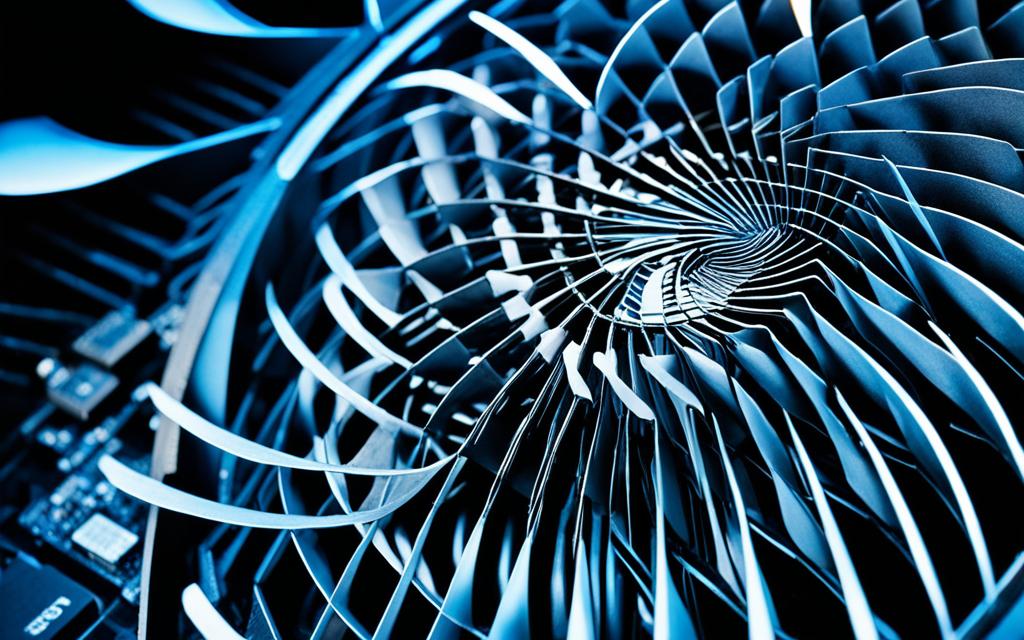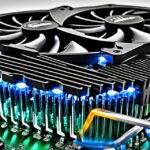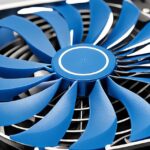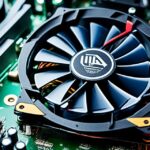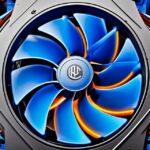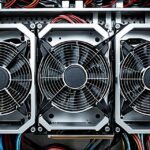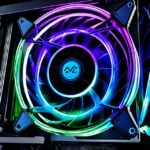Table of Contents
Finding out which way the air flows through a PC fan is key to better cooling. It’s important to know if a fan is taking air in or blowing it out. This helps you mount it in the best place for good airflow. There are a few ways to figure out a fan’s direction. You can look for an arrow on it or notice how the blades are shaped.
Key Takeaways
- Figuring out the airflow direction of PC fans improves cooling and sets up the airflow right.
- Look for arrows or signs on the fan body to know which way the air moves.
- Turning on the fan or feeling the air can also show you its direction.
- PC case fans are used in many electronic devices, not just computers.
- Being precise is very important when giving tech advice.
When you’re putting together a PC cooling system, think about airflow direction. Most PCs use a positive pressure setup. This means they have more fans pulling air in than pushing it out1. But sometimes, having more fans to push air out, or a negative pressure setup, works better1.
Not all PC fans have airflow arrows, though2. You should check the fan’s direction before you mount it. Look for arrows on the fan case that show rotation and airflow direction2. Another way is to turn the fan on and feel where the air goes2.
Remember, “PC case fans” aren’t only for PCs; they’re used in different electronics too2. When picking fans, think about how efficient they are, how much noise they make, and their look. The Arctic P12 PWM 120mm fan costs around $6 to $7 each in a pack of 5. It’s known for being quiet and moving air well1. The Noctua NF-A12x25 120mm fan, at $35 each, is praised for its high performance and quietness1. And for those who care about looks and functionality, the Lian Li UNI Fan V2 SL120 is a great RGB fan choice. It makes managing cables easier and adds cool lighting1.
In the end, knowing your PC fan’s airflow direction is crucial for the best cooling. You can find it through arrows, signs, feeling the airflow, or turning the fan on. Technical know-how and knowing about PC case fans help a lot in tech support2.
Looking for an Arrow Indicator
Knowing the airflow direction of PC fans helps improve cooling and keeps your computer running smoothly. While newer PC case fans often have airflow direction arrows3, some don’t. In those cases, looking at the fan blades’ curve can show the airflow path3.
Correct fan setup is key to preventing overheating and ensuring your computer performs well. For best airflow, your PC should have two intake fans for cool air and exhaust fans to expel warm air3. It’s also vital to understand if your PC case’s air pressure is neutral, positive, or negative. This depends on how intake and exhaust fans are balanced3.
Arrows or visual cues on fans help you install them the right way for efficient cooling. Make sure the arrow points in the right direction for air to move correctly inside your PC, whether you’re setting up intake or exhaust fans3. By checking the fan’s arrow or the shape of its blades, you can avoid airflow issues and keep your computer in top condition3.
Observing Fan Blade Shape
Many people find out the direction of a PC fan by looking for arrow indicators. But not all fans have these markers. In these situations, you can still tell which way the fan blows by looking at the blades’ shape.
If you notice the fan blades curve away from you, it means you’re looking at the intake side. This side draws in cool air. It’s vital for pulling fresh air into the system4.
When the blades curve towards you, you’re seeing the exhaust side. This is where warm air gets pushed out. Keeping hot air out is key to the system’s performance4.
Finding out the fan direction by blade shape is really useful. It’s great for fans without arrow signs. This ensures the fan works well and air moves properly inside the PC.
“The shape of the fan blades provides valuable insights into the fan’s direction, helping users optimize airflow and maintain optimal cooling efficiency”
Importance of Fan Direction for Airflow Configuration
Getting your PC fan direction right is key to making your PC cooler and run better5. Knowing how positive and negative pressure affects your system is very important for a good cooling system5. Let’s look at why the way your fans point matters in keeping your PC cool and working efficiently.
The Basics of Fan Direction
To improve airflow and cooling in your PC, placing your fans correctly is a must5. With a positive pressure setup, you have more intake fans. This stops hot air from staying inside and keeps dust away5. A negative pressure setup means having more exhaust fans to help cool the system down by taking out hot air5.
“The way you place and direct your fans is super important for keeping your PC cool. A smart airflow setup moves heat out well and makes cooling more effective. Knowing how different fan directions affect pressure helps get the best cooling.”
– Tom’s Hardware
The Impact of Fan Drection on Cooling Efficiency
The CPU fan’s blowing direction and the case fans impact how well your system stays cool6. Keeping your CPU cool can make it last longer6. When cooling parts align with the CPU fan flow, heat moves away more efficiently6. The best direction for CPU fan flow depends on your PC’s design, cooler position, and where heat builds up6.
Different setups show how important the right fan direction is for keeping things cool7. By understanding this, you can make your PC cooler and better at handling more intense use7. Using specific push/pull fan setups is a good way to manage air pressure inside the case7.
Advanced Cooling Techniques
Liquid cooling adds more ways to cool your PC, needing careful setup of fans7. It moves heat to radiators, where fans get rid of it7. The radiator fans’ direction also plays a big part in how effective this cooling is7. It’s important to know that water cooling setups vary and testing different arrangements is key7.
Considerations for Fan Direction
Setting up your fans the right way means looking at your PC’s design, cooler position, and where it gets hot6. Choosing how to place your fans, like using front intake or push-pull, directs cool air to your CPU6. For better cooling, using more intake fans in a positive pressure setup is helpful5. Controlling fan speed is also vital for keeping airflow smooth and cooling effective6.
Considerations for Choosing Fans
Choosing PC fans for your computer involves many factors. Fans not only help cool your system. They also affect fan performance and aesthetics8.
Fan size is the first thing to think about. PC fans vary in size, often measured in millimeters. For tight spaces or small builds, smaller fans work well. Larger fans, however, are quieter as they move more air at a lower speed9.
Consider if you need airflow or static pressure fans. Airflow fans are great for systems with good ventilation. Static pressure fans are better for pushing air through tight spaces, like radiators.
Many PC users like fans that look good. Fans with RGB lighting let you choose different colors. Using fans made from quality materials like aluminum can enhance your PC’s look8.
Not all fans are the same in performance. Fans like the Arctic P12 PWM mix good performance with low noise. They also look great in your PC8.
Fan thickness can affect how well they work. For example, the CORSAIR RS MAX fans are thicker than standard ones. This means they have larger blades for better airflow8.
But, 30mm fans might not fit in some PC cases. They can be too big, especially near the motherboard or coolers8.
Finding the right fans means thinking about cooling, noise, looks, and fit. Reviews and guides from places like Newegg Business and PC Site can help. Click here and here for more information.
Conclusion
Knowing which way your PC fan blows is key to making sure your PC stays cool. You can figure out the fan’s direction by looking for arrow signs or the way the blades curve. With the right fans and setup, your PC’s cooling can be greatly boosted.
While we don’t have hard numbers, lots of people talk and share advice about PC fan directions online10. Users like colanderman show how much fan setup matters for keeping PCs cool10.
Fans are not only important in computers but also in factories. They use a lot of electricity, about 78.7 billion kWh yearly, which is 15% of what motors use11. If a fan in a factory breaks, it can cause lots of problems, like stopping production11. Choosing the right fan can make the system quieter and more efficient11.
When it comes to preventing noise and keeping airflow smooth in PCs, the wire grill is the best pick12. It’s quiet and moves air well. In contrast, the turbine grill is noisy and bad at moving air12. Choosing the correct grill helps balance quietness with cooling.
To keep your PC in top shape, getting the fan direction and airflow right is crucial. Proper airflow and selecting the best fans for the job are key. This ensures your PC not only runs well but also lasts longer.
FAQ
How can I tell which way a PC fan blows?
You can find out a PC fan’s direction in a few ways. Look for arrows on the fan’s casing to show airflow direction. If there’s no arrow, check the fan blades’ shape. Blades that curve away mean the fan pulls in cool air. Blades curving towards you mean the fan pushes out warm air.
Is the direction of PC fan airflow important?
Indeed, knowing which way your PC fan blows is key for top cooling. It helps you decide on a positive or negative pressure setup. This knowledge is vital for optimal airflow and cooling efficiency in your PC.
What factors should I consider when choosing PC fans?
In choosing PC fans, look at size, noise, and airflow versus static pressure. Aesthetics matter too with options for lighting and materials. Better fans often mean quieter, more effective cooling. For quality picks, look at the Arctic P12 PWM, be quiet! Pure Wings 2, and Noctua NF-A12x25.
How can determining fan direction enhance cooling capabilities?
Figuring out fan direction helps in creating the best airflow setup. This ensures your system gets plenty of cool air. Opting for fans that mix performance with looks boosts cooling. This way, your PC stays cooler, running smoothly without overheating.
Source Links
- https://www.pcworld.com/article/394576/how-to-tell-which-way-your-fan-is-blowing.html – How to tell which way your fan is blowing
- https://www.techpowerup.com/forums/threads/how-to-know-the-case-fan-is-input-ouput.301978/ – How to know the case fan is input/ouput?
- https://www.cgdirector.com/pc-fan-airflow-direction/ – How to Tell Which Way Your PC’s Case & CPU Fans are Blowing
- https://www.electronicshub.org/pc-fan-airflow-direction/ – PC Fan Direction (PC Fan Airflow Direction)
- https://www.howtogeek.com/303078/how-to-manage-your-pcs-fans-for-optimal-airflow-and-cooling/ – How to Manage Your PC’s Fans for Optimal Airflow and Cooling
- https://softwareg.com.au/blogs/computer-hardware/cpu-fan-direction-of-airflow – CPU Fan Direction Of Airflow
- https://www.overclock.net/threads/rear-case-fan-direction.1585398/ – Rear case fan direction..
- https://www.corsair.com/us/en/explorer/diy-builder/fans/performance-difference-between-25mm-and-30mm-fans/ – Performance difference between 25mm and 30mm fans
- https://www.caaquebec.com/en/at-home/advice/tips-and-tricks/tip-and-trick/show/sujet/fans-blowing-in-the-wind – Fans: Blowing in the wind
- https://news.ycombinator.com/item?id=17170970 – Ask HN: Do I place the fan so that it blows air inwards or outwards?
- https://www.nrel.gov/docs/fy03osti/29166.pdf – Improving Fan System Performance – A Sourcebook for Industry
- https://www.pugetsystems.com/labs/articles/effects-of-grill-patterns-on-fan-performance-noise-107/ – Effects of Grill Patterns on Fan Performance/Noise

